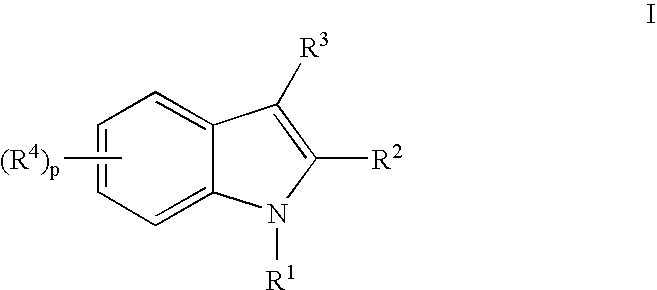Indoles Having Anti-Diabetic Activity
a technology of indoles and antidiabetic activity, which is applied in the field of indoles, can solve the problems of increased and premature morbidity and mortality, elevated plasma insulin levels that are not sufficient to meet the criteria of type 2 diabetes, and insufficient to overcome the pronounced insulin resistance of elevated plasma insulin levels, so as to achieve the effect of effective treatment and treatment of hyperglycemia
- Summary
- Abstract
- Description
- Claims
- Application Information
AI Technical Summary
Benefits of technology
Problems solved by technology
Method used
Image
Examples
example 1
See Scheme 5
Step 1. Preparation of Intermediate 4
[0199]
[0200]To a solution of glycolamide (14 g, 186 mmol) and diethyl carbonate (27.1 mL, 224 mmol) in methanol (200 mL) was added potassium t-butoxide (20.8 g, 186 mmol). The reaction mixture was refluxed overnight, then cooled to room temperature. The solvent was removed in vacuo. The residue was dissolved in brine, acidified with 2N HCl, then extracted with EtOAc. The organic layer was washed with brine, dried over Na2SO4, filtered, and concentrated in vacuo to give 8.0 g of oxazolidinedione as a white solid.
[0201]To a solution of the above obtained oxazolidinedione (4.6 g, 45 mmol) in CH2Cl2 (50 mL) were added TrCl (12.6 g, 45 mmol) and Et3N (6.3 mL, 45 mmol). The reaction mixture was stirred at room temperature for 40 min, then partitioned between water and EtOAc. The organic layer was washed with water and brine, dried over Na2SO4, filtered, and concentrated in vacuo to give the N-trityl OZD product.
[0202]To a solution of the ab...
example 2
See Scheme 6
Step 1. Preparation of Intermediate 13
[0208]
[0209]To a solution of NaHSO3 (10.7 g, 103 mmol) in water (150 mL) at 50° C. was added aldehyde 8 (19.3 g, 86 mmol). The reaction was stirred for 1.5 h at 50° C., then cooled to 0° C. Et2O (100 mL) was added, followed by a suspension of NaCN (4.66 g) in water (100 mL). After 2 h at 0° C., the layers were separated. The aqueous layer was extracted with ether. The combined organic layers were washed with brine, dried over Na2SO4, filtered, and concentrated in vacuo to give the cyanohydrin product as an oil.
[0210]To a solution of the product obtained above (10 g) in HCOOH (30 mL) at 0° C. was added slowly concentrated HCl (30 mL). The reaction was stirred at 0° C. for 2 h, poured over crushed ice, extracted with EtOAc (2×). The combined organic layers were washed with water, 1.0 N NaOH aqueous solution (3×), brine, dried over Na2SO4, filtered, and concentrated in vacuo to give the amide as white solid.
[0211]To a solution of the am...
example 3
See Scheme 7
Step 1. Preparation of (R)-diol 18
[0217]
[0218]To a suspension of methyltriphenylphosphonium bromide (33.2 g, 92.9 mmol) in diethyl ether (200 mL) at room temperature was added slowly nBuLi (2.5 M in hexanes, 37 mL). The resulting yellow solution was stirred for 30 min before ketone 16 (12 mL, 90 mmol) was introduced. The reaction was stirred at room temperature overnight. The precipitate was removed by filtration. The solvent was removed in vacuo. Purification by flash chromatography gave the alkene product.
[0219]To a suspension of AD-mix-β (7 g) in H2O / tBuOH (25 mL / 25 mL) at 0° C. was added the above obtained alkene (0.66 g, 5 mmol). The reaction mixture was stirred at 0° C. overnight. Na2SO3 (7.5 g) was added. After 1 h at room temperature, the mixture was extracted with EtOAc (3×). The combined organic layers were washed with brine, dried over Na2SO4, filtered, and concentrated in vacuo. Purification by flash chromatography gave the (R)-diol 18.
[0220]1H NMR (500 MHz, ...
PUM
| Property | Measurement | Unit |
|---|---|---|
| volume | aaaaa | aaaaa |
| concentrations | aaaaa | aaaaa |
| flow rate | aaaaa | aaaaa |
Abstract
Description
Claims
Application Information
 Login to View More
Login to View More - R&D
- Intellectual Property
- Life Sciences
- Materials
- Tech Scout
- Unparalleled Data Quality
- Higher Quality Content
- 60% Fewer Hallucinations
Browse by: Latest US Patents, China's latest patents, Technical Efficacy Thesaurus, Application Domain, Technology Topic, Popular Technical Reports.
© 2025 PatSnap. All rights reserved.Legal|Privacy policy|Modern Slavery Act Transparency Statement|Sitemap|About US| Contact US: help@patsnap.com



